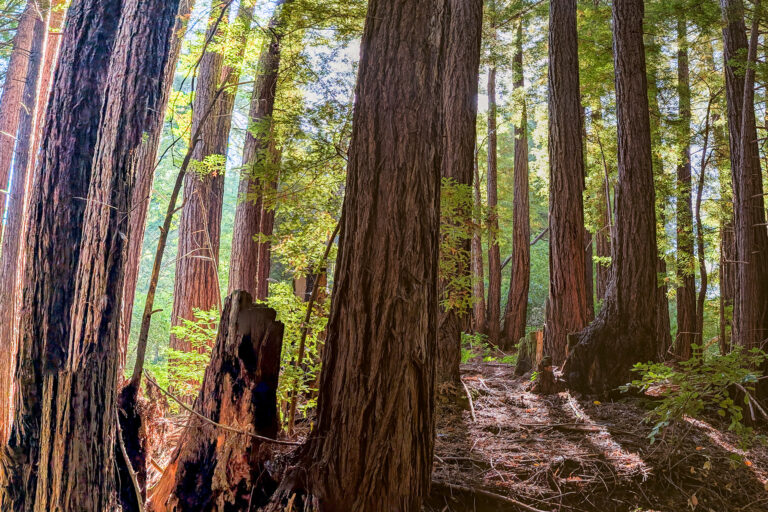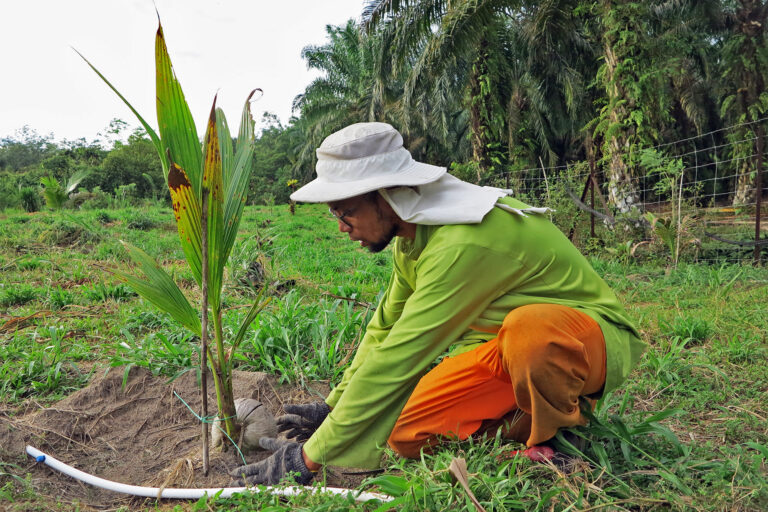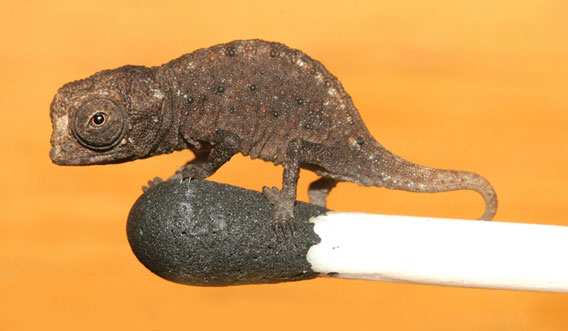
Juvenile Brookesia micra on match.
Scientists have discovered four new species of super-tiny chameleons in Madagascar, according to a new paper in PLoS ONE. The smallest of the new species, Brookesia micra, is found only on the small island of Nosy Hara and has been dubbed the smallest chameleon in the world, measuring from nose to tail 29 millimeters (1.14 inches) at its largest. Scientists believe it represents a notable example of island dwarfism.
“The extremely small size of Brookesia micra could represent a ‘double’ island dwarf effect. In this scenario, Madagascar as a large island led to the evolution of the Brookesia minima group whereas the […] islet Nosy Hara, might have favored the extreme miniaturization found in Brookesia micra,” the researchers write. However they note it is also possible, given the shallowness of the sea between Nosy Hara and Madagascar, that populations of Brookesia micra survive on the mother island.
With these four new species, scientists have catalogued 26 Brookesia chameleons in all. These chameleons, which are endemic to Madagascar, inhabit the leaf litter during the day, but move up into the trees at night to sleep, a time when it becomes relatively easier for scientists to find them. On catching individuals, researchers used genetic analysis to determine species. The analysis revealed that many of these species are separated by millions of years, representing an ancient lineage of reptiles.
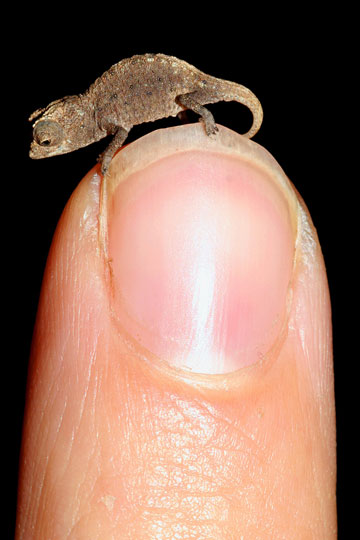 Juvenile Brookesia micra on a fingertip. |
“The extreme miniaturization of these dwarf reptiles might be accompanied by numerous specializations of the body plan, and this constitutes a promising field for future research.” says co-author, Frank Glaw with the Zoological State Collection of Munich, in a press release. “But most urgent is to focus conservation efforts on these and other microendemic species in Madagascar which are heavily threatened by deforestation.”
With extremely small ranges, these chameleons are gravely imperiled by habitat loss. One of the new species was named Brookesia desperata for “desperate”. Although the species was found in a protected area, the Forêt d’Ambre Special Reserve, researchers fear it may be close to extinction.
“Its habitat is in truth barely protected and subject to numerous human-induced environmental problems resulting in severe habitat destruction, thus threatening the survival of the species,” they write.
Another of the new species may be even worse off: Brookesia tristis, meaning “sorrowful.”
“The entire known range of this species (Montagne des Français) suffers from severe deforestation and habitat destruction despite recently being declared as a nature reserve,” the researchers write.
Madagascar suffers from a booming population and severe poverty, putting massive pressure on its remaining forests and unique wildlife, including over a hundred species of lemurs. Worsening matters, the country recently suffered a logging crisis. Following a government coup in 2009, many of the nation’s parks were beset by illegal rosewood logging urged by foreign traders. Raw rosewood often made its way to China where it was made into high-end luxury furniture.
CITATION:Glaw F, Köhler J, Townsend TM, Vences M (2012) Rivaling the World’s Smallest Reptiles: Discovery of Miniaturized and Microendemic New Species of Leaf Chameleons (Brookesia) from Northern Madagascar. PLoS ONE 7(2): e31314. doi:10.1371/journal.pone.0031314.

World’s smallest chameleon: Brookesia micra.
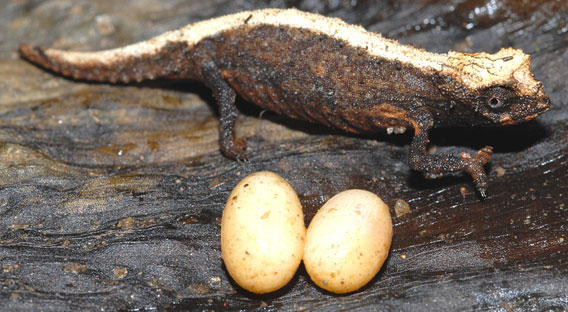
Brookesia desperata with eggs.

Distribution map of new chameleons in Madagascar. Click to enlarge.
Related articles
Photos: 40% of Madagascar’s reptiles at risk of extinction
(11/10/2011) 40 percent of Madagascar’s terrestrial reptiles are threatened with extinction due to habitat loss and over-collection for the pet trade, reports the International Union for Conservation of Nature (IUCN) in its latest update of the Red List of Threatened Species.
Photo: Tiny lemur discovered in Madagascar forest
(01/08/2012) A new species of mouse lemur has been discovered in eastern Madagascar, report researchers from Germany. The species is described in a recent issue of the journal Primates.
Photos: 600 new species discovered in Madagascar since 1999
(06/06/2011) More than 600 species of plants and animals have been described in Madagascar over the past decade, reiterating the position of Indian Ocean island as one of the world’s top biodiversity hotspots, says a new report issued today by WWF.
Photos: the top ten new species discovered in 2010

(05/23/2011) If we had to characterize our understanding of life on Earth as either ignorant or knowledgeable, the former would be most correct. In 250 years of rigorous taxonomic work researchers have cataloged nearly two million species, however scientists estimate the total number of species on Earth is at least five million and perhaps up to a hundred million. This means every year thousands of new species are discovered by researchers, and from these thousands, the International Institute for Species Exploration at Arizona State University selects ten especially notable new species.
New population of nearly extinct Madagascar chameleon discovered
(03/01/2011) Scientists have discovered a new population of the Belalanda chameleon (Furcifer belalandaensis), boosting hope for one of Madagascar’s rarest chameleons.
Image: new bird discovered in Madagascar
(02/24/2011) The rich and unique biodiversity of Madagascar has a new member: a forest dwelling bird in the rail family, dubbed Mentocrex beankaensis. In 2009 US and Malaygasy scientists conducted a survey in Madagascar’s dry Beanka Forest. They discovered several new species, of which the new rail is the first to be described.
Madagascar tree diversity among the highest worldwide

(12/12/2011) In terms of biodiversity, the hugely imperiled forests of Madagascar may be among the world’s richest. Researchers estimate that the island off the coast of Africa is home to at least 10,000 tree and shrub species with over 90 percent of them found no-where else in the world. With little baseline data collected on Madagascar’s ecosystems, a new study, the first ever of tree diversity in Madagascar lowland rainforests, hopes to begin the process. Published in mongabay.com’s open access journal Tropical Conservation Science, the new study surveyed tree species in eastern Madagascar’s Betampona Special Reserve.
Tea Party rallies in favor of Gibson Guitar, ignores reasons instrument-maker is under investigation

(10/10/2011) This weekend around 500 people showed up for a rally and concert in Nashville, Tennessee. The rally was in support of Gibson Guitars, a US-company currently under investigation for allegedly importing illegally logged wood into the country, an action that breaks a recent bipartisan amendment to the Lacey Act. While the Tea Party-affiliated groups that held the rally were expressing frustration with perceived over-regulation by the federal government, the issue at stake—a global effort to help stem illegal logging—was actually overlooked by the organizers.
Tea party versus Madagascar’s forests

(10/02/2011) The Tea Party and the African island-nation of Madagascar are having dueling concerts over the issue of illegal logging, reports the Associated Press. A concert in Madagascar over the weekend was meant to highlight the problem of illegal deforestation in one of the world’s poorest countries. Meanwhile the Tea Party is holding a rally and concert on October 8th to support Gibson Guitar, a musical instruments company currently under investigation for breaking US law by allegedly purchasing illegally logged wood products from Madagascar.









